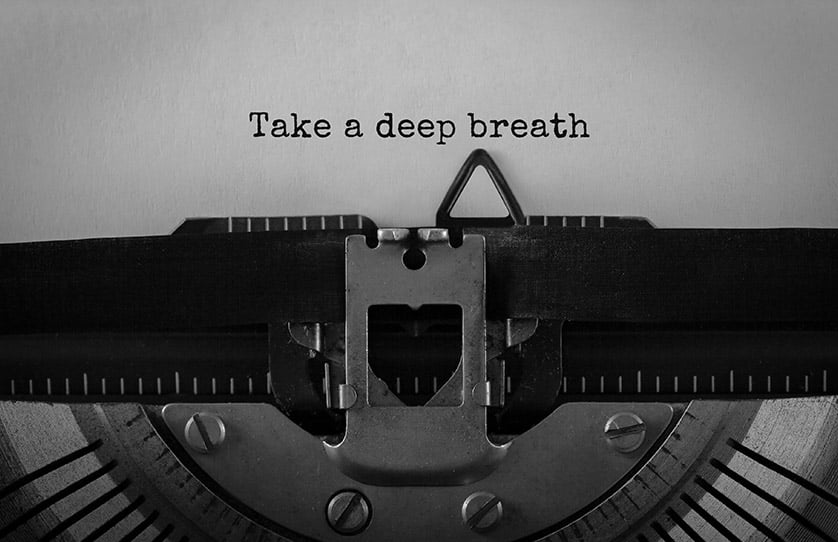Breathing is something we do all day without giving it any thought. From the moment we take our first breath, to the time we breathe our last, we unconsciously take in air and let it out again. But have you ever wondered if you’re doing it right?
Diaphragmatic breathing is essential to your health, mind, and ability to perform under pressure. It helps to focus your mind for better concentration and decision making. It improves health both through proper oxygenation of your blood and detoxifying the body.
What is diaphragmatic breathing?
Located horizontally between the thoracic cavity and the abdominal cavity is the diaphragm. This muscle contracts as you inhale to make room for your lungs to expand, allowing for your lungs to fill completely. As you exhale, this muscle helps push all the toxin filled air out of your lungs.
When using diaphragmatic breathing, your stomach area should expand out when you breath in and deflate again as you exhale. Often times we are not taking these full deep breaths as we should. This is primarily due to how much time we spend sitting, or slouched over as we work at our desks all day, restricting the movement of the diaphragm.
This restriction leads us to take frequent shallow breaths instead of full, deep, lung-filling inhales and exhales. To get an idea of just how important breathing is to your health and wellness, let’s take a look at the exact opposite of proper breathing: hyperventilation.
Hyperventilation and its effects
Hyperventilation is described as rapid, shallow breaths. This type of breathing often occurs when we are anxious or panicked.
Hyperventilation:
- lowers your blood’s carbon dioxide levels
- raises pH levels
- decreases levels of calcium and potassium in the blood
- decreases blood flow to the brain
Results from hyperventilation range from:
- Spasms
- Seizures
- Fainting
- Numbness
- Increased heart rate
- Loss of emotional control
- Hallucinations
Importance of proper breathing
Diaphragmatic breathing is key to so many components of our lives. It relieves anxiety, stress, and tension. It aids in regulating emotions and activates the parasympathetic nervous system, where our calming receptors are located.
Proper breathing lowers the release of stress hormones, maintains optimal heart rate for cognition and performance, and brings on inner peace. It detoxifies the blood and improves oxygen levels throughout the body.
It strengthens the diaphragm, improves posture, aids in digestion, and dealing with pain. Diaphragmatic breathing helps control anger and fear so we can properly respond to situations, it strengthens our lungs, and improves muscle flex through proper oxygenation.
Along with lowering stress, proper breathing lowers blood pressure, strengthens respiratory muscles, and prevents upper body tension in your neck, shoulders, and back. It enhances core stability and reduces muscle fatigue and injury while improving tolerance of high intensity exercise.
Steps to Proper Diaphragmatic Breathing
The following steps will help illustrate diaphragmatic breathing to ensure you are getting the most out of every breath.
- Find a place to lie down flat on your back.
- Put one hand on your stomach and one on your chest.
- Take in a slow deep breath through your nose (if possible) as you count to 4 in your mind
- You should feel your stomach rise first as you breath in, then your chest as your lungs continue to fill
- Hold for a count of 2
- Exhale slowly through your mouth as you count to 4, letting your stomach deflate first then continuing to breathe out until your lungs have emptied
Breathing Exercises
Now that you know the right way to breathe, you’re body and mind will begin to heal from all the years of improper breathing. While you may not notice any results right away, trust that you’re making a positive impact on your overall well-being.
In addition, you can practice deep breathing exercises to strengthen and improve your body and mind. These techniques are specifically designed to improve your breathing, release tension, reduce pain, increase energy, or help you to relax.
Combat Tactical Breathing - excellent for reducing stress and calming down
❏ Slowly i inhale as you count to 4
❏ Hold it for a count of 4
❏ Slowly exhale 1, 2, 3, 4
❏ Hold for a final count of 4
❏ Repeat as needed until you are calmed
Muscle Tension Relief
❏ Stand straight, bend forward at the waist with knees slightly bent.
❏ Let your arms dangle loosely at your sides.
❏ Slowly inhale as you roll back to an upright position, lifting head last.
❏ Exhale slowly as you return to the starting position
❏ Stretch your arms above your head
❏ Relax
❏ Repeat 3-5 times
Bellows Breath - stimulates the diaphragm and increases alertness
❏ Rapidly inhale and exhale several quick short breaths through the nose, keeping mouth closed
❏ Do this for about 10 seconds
❏ Breathe normally, in through the nose, out through the mouth, slow and steady
❏ Repeat several times

